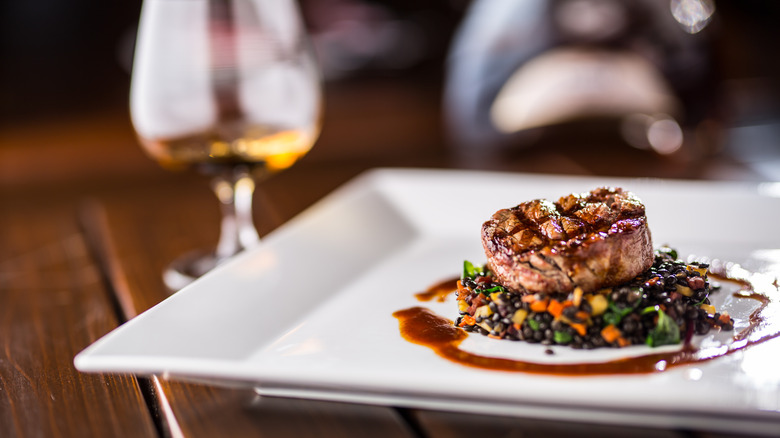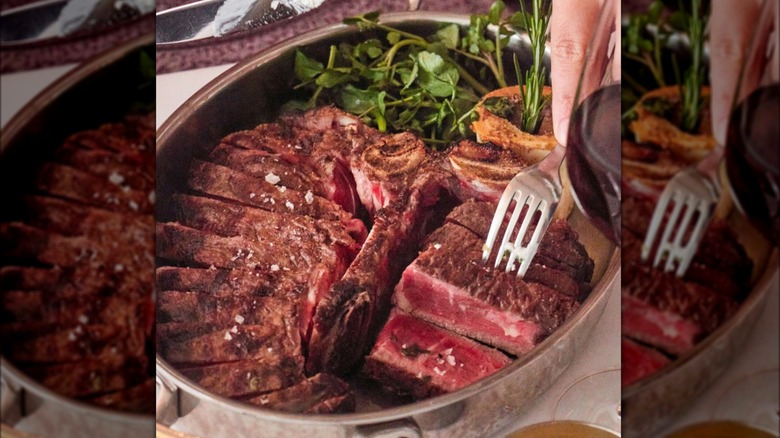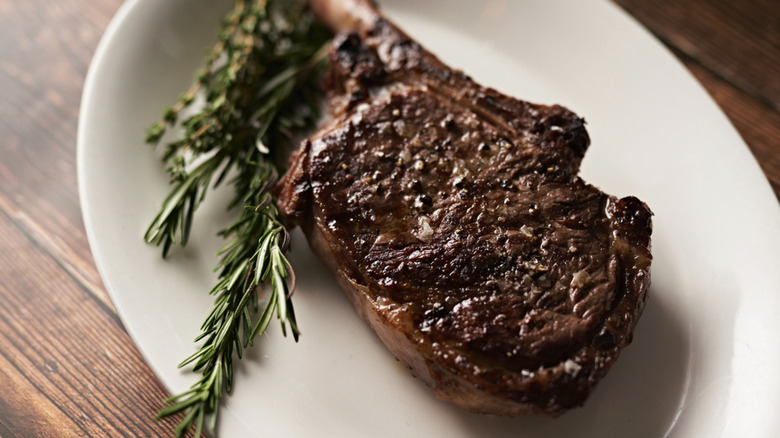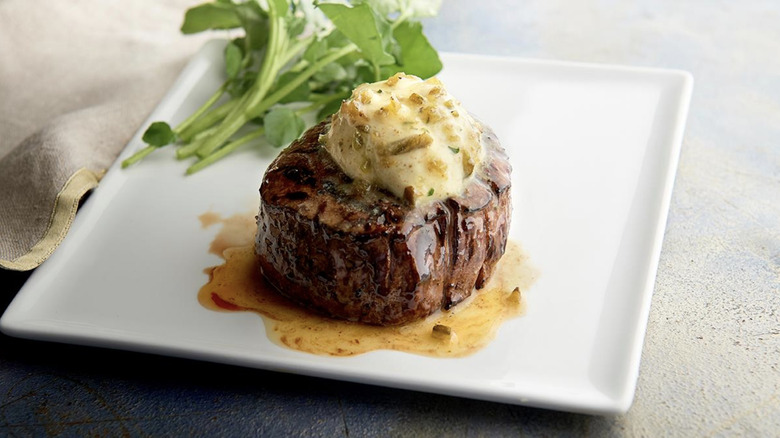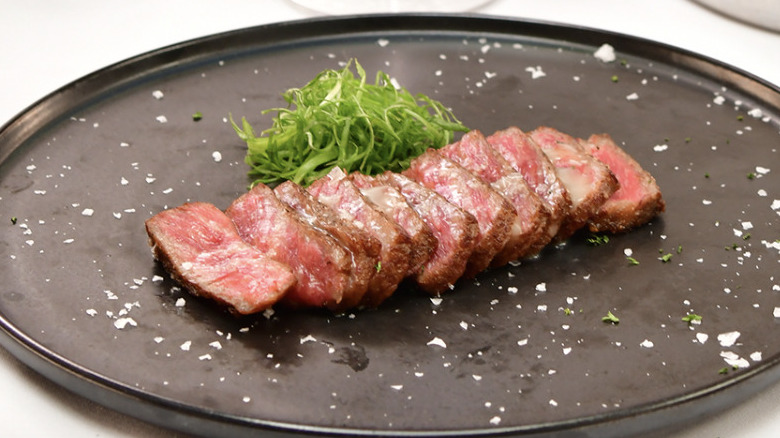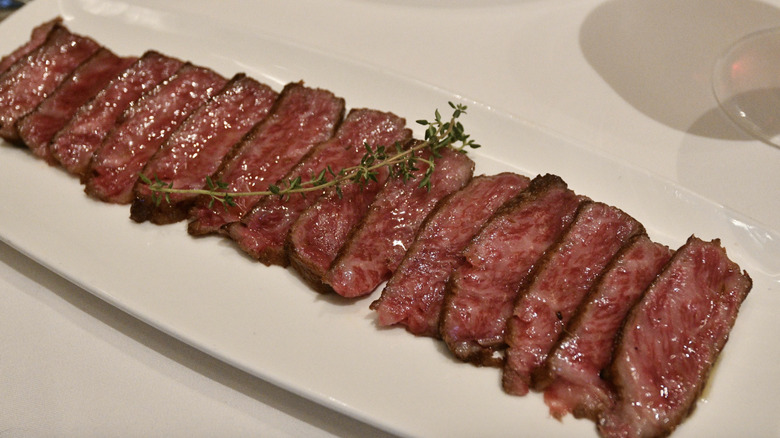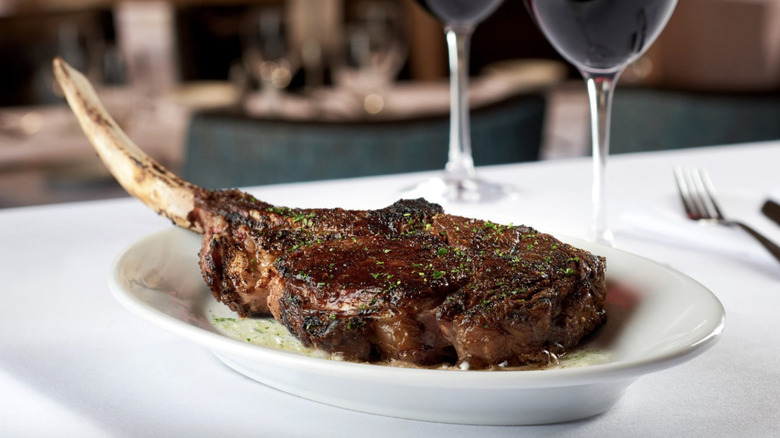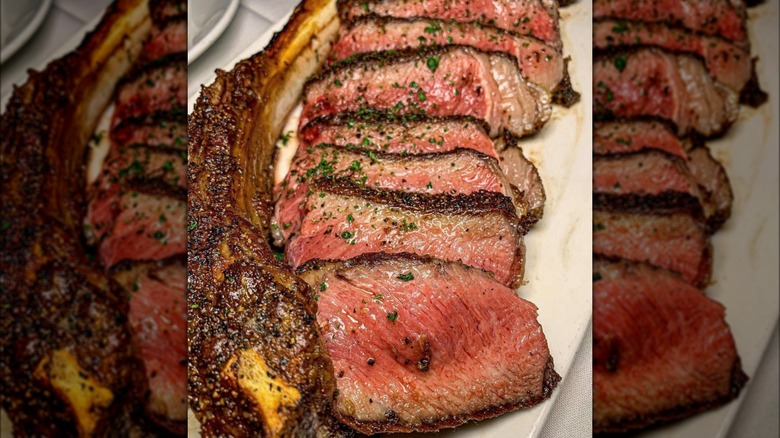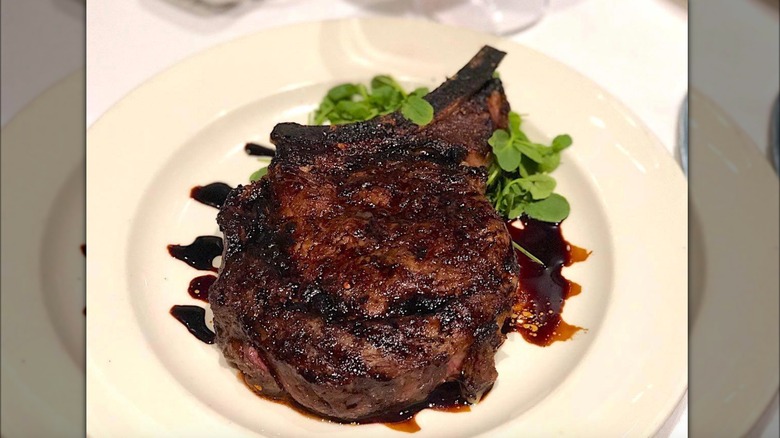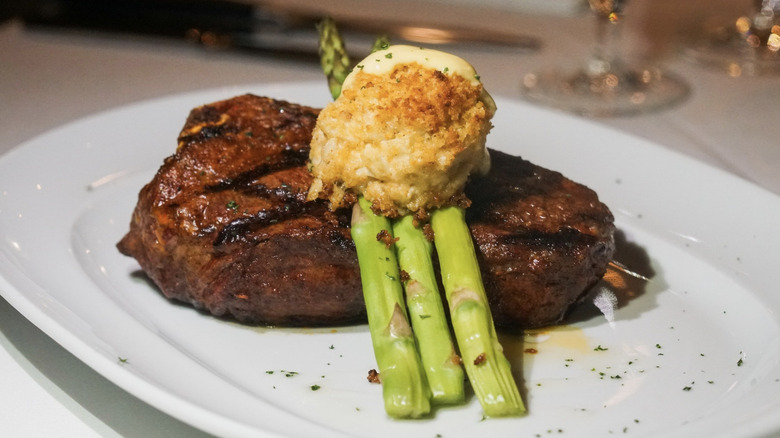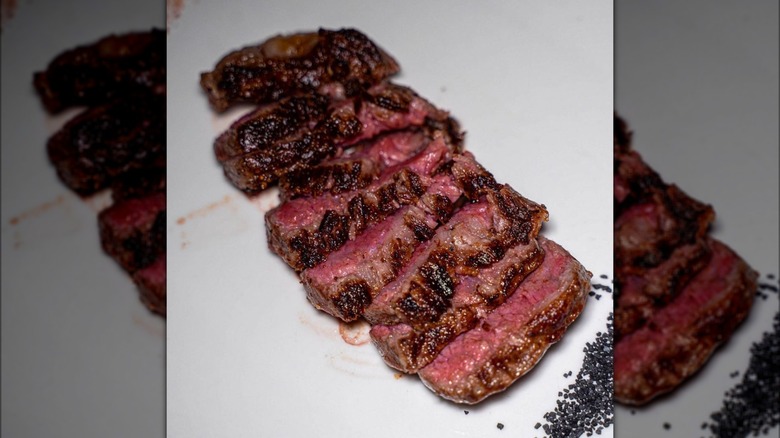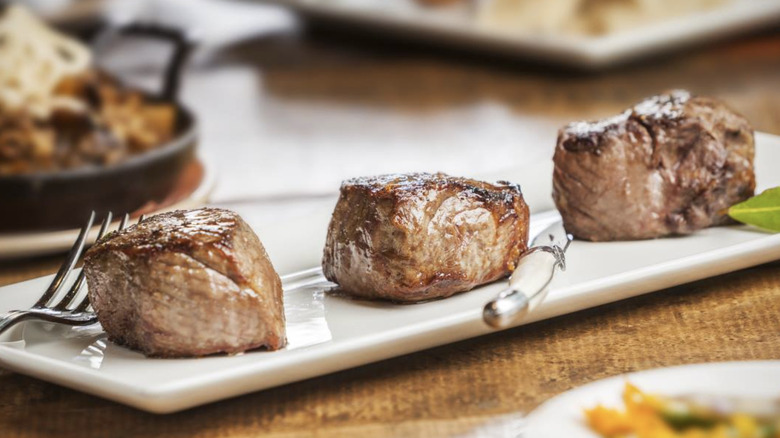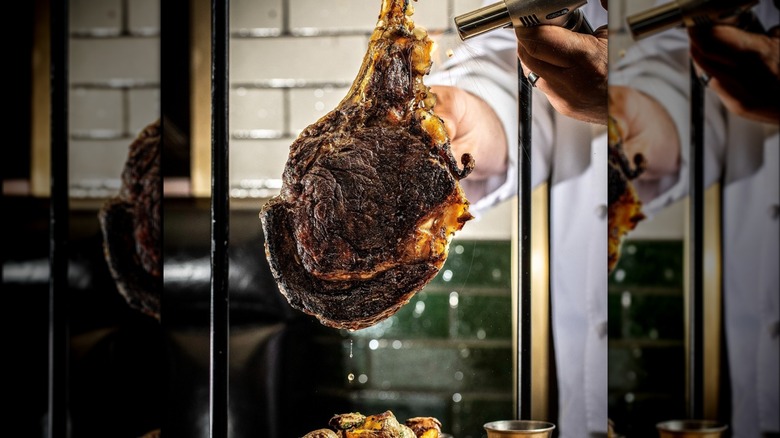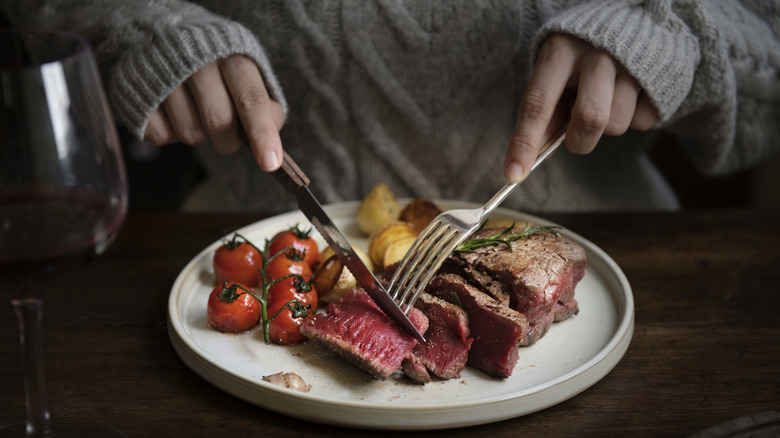The Most Expensive Steak At Popular Steakhouse Chains Ranked, According To Customers
Renowned for serving high-quality cuts of beef, steakhouses feature a range of steak options, from ribeye and sirloin to filet mignon. Many steakhouses also pride themselves on using cooking techniques that enhance the natural qualities of the meat. Be it grilling, broiling, or pan-searing, these methods are crucial for imparting the beef with a unique flavor and texture. The degree of doneness — rare, medium, or well-done — further tailors the steak to individual preferences, imparting each cut with a unique flavor profile.
Despite the allure of a flawlessly prepared steak, the cost of high-quality cuts can be substantial. Premium steaks such as Japanese Kobe beef, filet mignon, and tomahawk ribeye often carry a hefty price tag due to several factors such as breed rarity and cattle feeding practices. Couple this with the expertise required to prepare a perfectly cooked steak and the ambiance of an upscale chain steakhouse, and the cost can become surprisingly high.
To help you get the best value for your money, we compared the most expensive steak offerings at popular steakhouse chains across the U.S. While compiling our list, we looked at a number of factors, including beef quality and customer feedback. To find out more about our selection criteria, take a look at the methodology section at the end of this article.
12. Charlie Palmer Steak: Dry Aged Prime Porterhouse
With only four locations — in New York, Reno, Napa, and Washington, D.C. — Charlie Palmer Steak is a relatively small player in the steakhouse industry. While we aren't sure where the chain sources its beef, according to the Charlie Palmer Steak website, the restaurant places "extra focus on buying meat directly from small producers who are focused on giving us cleaner, more fully flavored beef." Among its steak dishes, Charlie Palmer features a 32-ounce Dry Aged Prime Porterhouse for two, which diners can complement with one of three sauces at an extra charge: bourbon au poivre chimichurri, béarnaise sauce, or the mysterious-sounding secret sauce.
According to the Charlie Palmer Steak's team, the $157 Dry Aged Prime Porterhouse is "always a great option." Unfortunately, many diners disagree, saying that their rendition of the steak was poorly prepared and lacked flavor. One patron of the New York location found their dining experience disappointing, saying on Yelp, "The steak came out [at ] room temperature while the sides were piping hot." Meanwhile, another diner in New York complains that their dish was unevenly cooked, adding, "I asked for medium well and at first I felt that it was my own fault for ordering this temperature so that it came burnt. But the char was THICK and a good part of the steak was undercooked, more medium than medium well ... indicating that whoever made this steak just didn't cook it well."
11. Shula's: Cowboy Ribeye
Shula's sources its meat from The Graham Angus Farm, which specializes in Angus beef. In fact, the chain claims that its beef is superior to USDA Prime, the highest grade of beef certified by the United States Department of Agriculture. This is because the Graham Angus Farm adheres to 10 stringent specifications, nine of which exceed those required for beef graded USDA Prime. This positions the chain's beef among the top 1% of all beef offered in restaurants. Perhaps this is why Shula's steaks are so expensive. In fact, none of the restaurant's offerings cost under $60. One of these is the Cowboy Ribeye, a 22-ounce bone-in ribeye steak with the price tag of $79.
Although Shula's marketing team seems impressed with the offering, proclaiming "Time to saddle up for supper, cowboy," not everybody shares this enthusiasm. Some customers express satisfaction with their steak choice; however, these are in the minority. For instance, one dissatisfied reviewer says, "I ordered the 22 oz cowboy rib-eye, medium well. I was brought a well-done 16 oz. I know my steaks. And this was not a 22 oz no matter how [it was] cooked." Another diner says that while their steak was flavorful and cooked correctly, it was a little tough in texture.
10. Morton's The Steakhouse: Wagyu Filet
At $74 for seven ounces, Morton's Wagyu filet is an expensive choice. Sourced from several Japanese cattle breeds, Wagyu beef is known for its intense marbling, rich flavor, and tender texture. To put things in perspective, while American Wagyu is technically classified as USDA Prime, it occupies the highest tier within that classification. We do know that Morton's Wagyu ribeye comes from Westholme farms in Australia, however, it's unclear whether its Wagyu Filet hails from the same location.
Morton's Wagyu Filet has elicited a range of feedback from steak enthusiasts. On the positive side, some diners have praised the cut, calling it delicious and absolutely amazing. However, many others have delved into the less favorable aspects of the dish. One patron says: "The menu advertises Wagyu filet mignon. But it's nothing like A5 Wagyu. In fact, their Wagyu wasn't even as good as their regular Filet Mignon. The Wagyu had a slight rubberiness to it even though it was cooked medium rare. Whereas the regular Filet Mignon was very tender." Another diner agrees, saying on Yelp, "Morton's 'Wagyu steak' is basically a Filet Mignon, so you might as well save your $$ and order a filet instead."
9. Mastro's Restaurants: True A5 Kobe Beef
If you order the True A5 Kobe Beef at Mastro's, you'll be ordering the most expensive type of beef in the world. In fact, four ounces of the beef at the restaurant will set you back a cool $240. This beef's steep price is due to its rarity and the labor-intensive methods of raising it. The chain's True A5 Kobe Beef comes from Tajima cattle from Japan's Hyogo Prefecture and ranks as the highest grade of Kobe beef possible. One of Mastro's chefs explains why the cut is so sought after, saying, "The reason why it's so exclusive is that only 3,000 head of Kobe cattle are butchered every year, of which only 4,500 pounds comes to America" (via TikTok).
Mastro's serves its True A5 Kobe Beef broiled and lightly seasoned with black pepper and sea salt to maintain the steak's natural taste. However, considering the cut's steep price tag and mixed reviews, we can't say that we can recommend it. While some diners have loved the steak calling it the best ever and great, others haven't been as impressed. For instance, one disappointed customer says on Open Table: "Ordered a $240 A5 Kobe steak. It was mostly fat. I'm not referring to the natural marbling in A5. This was almost all tough pieces of fat. By far the worst A5 I've ever had." Other diners have complained that the dish was overcooked or served freezing cold inside.
8. The Palm: Kagoshima A5 Wagyu New York Strip
At $129 for eight ounces, the Kagoshima A5 Wagyu New York Strip is the most expensive steak on The Palm's menu. Known for its rich flavor and high marbling, the Wagyu comes from cattle raised in the Kagoshima Prefecture in Japan. The beef has been classified as A5, the highest possible quality rating for Japanese Kagoshima beef. Furthermore, the New York strip is cut from the short loin of a cow, renowned for its robust flavor, a good amount of marbling, and juicy and tender texture.
Despite its notable pedigree, The Palm's Kagoshima A5 Wagyu New York Strip has elicited a range of feedback from customers, both positive and negative. Just a few of the adjectives used by reviewers to describe the dish have included great, phenomenal, and amazing. Unfortunately, the story doesn't stop there. On the downside, one disappointed diner says: "We specific[ally] asked it to be medium cooked ... [but it looked] rare cooked, and by the second bite it was cold already ... More like a piece of fat with less than 10% meat sticking to it." Another diner seconds this assessment, saying, "Worst wagyu beef I've ever had — the meat was fatty and bright pink (I had ordered medium)."
7. Ruth's Chris Steak House: Tomahawk Ribeye
Featured in the Specialty Cuts section of the menu at Ruth's Chris Steak House, the Tomahawk Ribeye is a USDA Prime bone-in cut. This 40-ounce steak is known for its distinctive look that echoes a Native American tomahawk. Made with corn-fed Midwestern beef, the ribeye comes with a long frenched bone that's been meticulously cleaned of meat and fat. The $149 steak is broiled at 1,800 degrees Fahrenheit and served on a sizzling 500-degree plate to maintain the perfect temperature throughout the meal. The dish is garnished with butter and parsley for added flavor.
Reactions to the Tomahawk Ribeye at Ruth's Chris have been varied, including compliments and complaints. In particular, fans of the dish have highlighted that the steak was perfectly cooked, well-presented, and delicious. However, many dissatisfied reviews have taken issue with the steak's preparation, with one Reddit user complaining that their steak was undercooked. Even more damning, another unimpressed diner posted on Trip Advisor that their Tomahawk Ribeye was tough and wasn't a tomahawk at all, commenting, "It came with the meat cut off the bone. We asked why and were told that if we didn't want the meat cut off the bone we should have told the waiter."
6. Fleming's Prime Steakhouse & Wine Bar: Prime Tomahawk
Made with USDA Prime beef, Fleming's Prime Steakhouse's Prime Tomahawk represents the top 2% of all cuts rated by the organization. In addition, the chain prides itself on sourcing its beef from family-managed farms throughout the Midwest. Once in the restaurant's kitchen, the bone-in steak is broiled at 1,600 degrees Fahrenheit to seal in flavors and juices. Moreover, this $100, 35-ounce cut of beef is seasoned with salt and pepper and seared to create a steak crust. The Prime Tomahawk is served on a 350-degree plate to ensure that it keeps an optimal temperature. Plus, it's topped with your choice of butter, including béarnaise, smoked chili, or herbed horseradish.
Customer reactions to Fleming's Prime Steakhouse's Prime Tomahawk have ranged from enthusiastic to underwhelmed. Several satisfied reviewers highlight the steak's rich flavor, with comments like, "It was delicious! ... Well-seasoned and absolutely juicy" and "[It] charred perfectly and I could see a perfect medium rare deep pink color that I so adore" (via 2BigBoys). Delving into the less favorable feedback, some reviewers have noted issues with the steak's flavor, texture, and portion size. One remarks on Trip Advisor, "I guess most of that 35 oz. steak was in the bone because the edible portion I'd estimate was barely a pound and was only about an inch and a quarter thick and barely warm." Meanwhile, another patron says that their steak was unseasoned and charred, and yet another describes it as somewhat chewy.
5. The Capital Grille: Porcini Rubbed Bone-In Ribeye with 15-Year Aged Balsamic
A part of the Chef's Suggestions portion of The Capital Grille's menu, the Porcini Rubbed Bone-In Ribeye with 15-Year Aged Balsamic is one of the chain's prides and joys. In fact, it's one of the favorite dishes of The Capital Grille's chef executive partner, Marc Gruverman. "The earthy flavor from the porcini rub is balanced perfectly against the sweetness and acidity of the aged balsamic," he told Fort Lauderdale Magazine in an interview. While The Capital Grille's menu doesn't specify the cut's size, we do know that the chain's cuts of beef are dry-aged for 18 to 24 days and cut in-house.
While the dish has some critics, most diners agree that The Capital Grille's porcini rubbed bone-in ribeye is worth its $87 price point. One happy customer says: "The porcini rubbed ribeye is probably one of the best steaks ever concocted." Several other patrons echo this sentiment, describing the dish as delicious, amazing, and incredible. On the downside, the steak has also been criticized for being flavorless, with one diner saying on Yelp, "There was, it seemed like, probably 4 or 5 oz of fat and chewy gristle. So disappointed."
4. Steak 48: Filet Mignon
Although still pricey, at $76 per 12 ounces, Steak 48's Filet Mignon is decent value for your buck, as far as top-range USDA Prime tenderloin cuts go. Expertly prepared, the beef is wet aged for 28 days and hand-cut by the chain's Master Butchers. Wet aging is a process where cuts of beef are sealed in vacuum-packed plastic bags and refrigerated for a period of time. This method allows the meat's natural enzymes to break down the meat's muscle tissue, resulting in superior tenderness, juiciness, and flavor. Steak 48's Filet Mignon is available with a variety of enhancements for an extra cost, including black truffle sautéed black lobster, crab cake "oscar," and chef-style burrata.
Most diners have been pleased with Steak 48's Filet Mignon, with a few complaints pertaining to the meat's preparation method rather than its quality. On the positive side, one customer describes the dish as "juicy, tender, and delicious," while another calls it phenomenal. Yet another enthused reviewer says: "I've had filet mignon hundreds of times all around the world — this is flat out one of the best." However, the steak may not always arrive at the table cooked to your specifications, as highlighted by one customer who says: "I ordered a filet mignon med well and it was more than med well and dry."
3. Del Frisco's Double Eagle Steak House: Japanese A5 Wagyu Steak
Del Frisco's Double Eagle Steak House offers six-ounce Japanese A5 Wagyu Steaks for $160. The chain also serves Wagyu Meatballs, which we are guessing are made from the Wagyu offcuts and a lot of filler since they only cost $20. While the menu doesn't specify exactly where Del Frisco's sources its Wagyu, the restaurant's website does mention the Akaushi cattle lineage. Translating to "red cow" in Japanese, the Akaushi breed produces exceptionally marbled, tender, and flavorful cuts of beef.
The team at Del Frisco's describes its Japanese A5 Wagyu Steaks as "rich and tender with every bite." They also add that the cuts feature "exquisite marbling and a buttery texture." Indeed, the chain's Wagyu has stirred mostly positive feedback from customers. Several diners have been highly impressed with the dish, calling it delicious and melt-in-the-mouth tender. One diner proclaims: "It's an investment, but worth it!" adding that their steak was both beautifully marbled and rich. However, not all customer feedback about the chain's Wagyu has been positive; some diners call it overpriced. For instance, one diner says on Trip Advisor: "For [that price] you want it perfect and sadly it was cold."
2. Urban Farmer: New York Steak Tasting
Urban Farmer is one of the few steakhouses that offers a steak tasting option on its menu, allowing diners to sample a variety of cuts side by side. For $80, customers can try three different six-ounce New York steaks. These include Niman Ranch grass-fed beef from Colorado, Creekstone corn-finished beef from Kansas, and 21-day dry-aged, grain-finished beef from Pennsylvania. For an additional $45, diners can also opt to upgrade their tasting meal with a six-ounce cut of Washugyu Wagyu from Oregon. Matt Christianson, the Executive Chef at Urban Farmer, praised the concept of steak tasting in an interview with Modern Farmer, saying, "To describe the difference between the qualities of each type of beef always falls short on words. Within a steak tasting, you get the fullness of the description within your mouth on only one visit."
The majority of diners agree that the chain's steak tasting menu features high-quality beef and is a great way of comparing the flavors and textures of different types of meat. Perhaps one patron sums this up best, saying, "Amazing how three steaks can be all amazing and still taste completely different. Melt in your mouth good! What's funny is that each of us had a different favorite of the three." Another diner also praises the experience, noting, "We could definitely taste the differences between the three options, and we both ended up preferring the leaner grass-fed beef ... All were cooked exactly to our preference."
1. Smith & Wollensky: Swinging Tomahawk Ribeye
One of the standout features of Smith & Wollensky's $240 Swinging Tomahawk Ribeye is its distinctive preparation method. This hefty 44-ounce steak is expertly seared at the table using a high-heat blowtorch. Underneath the steak, a strategically placed bowl of potatoes catches the dripping beef fat to create an exquisite side dish. The steak is crafted from superior black-grade American Wagyu, sourced from Snake River Farms, a grade that surpasses USDA Prime. Additionally, the restaurant ages the cuts in-house for at least 28 days to enhance their flavor and tenderness.
To say that Smith & Wollensky's Swinging Tomahawk Ribeye has been a hit with diners would be an understatement. The chain's patrons rave about the cut's preparation, presentation, and flavor. For instance, one reviewer says: "The swinging tomahawk & meat fat potatoes [are] EVERYTHING! The presentation is amazing. They torch it at the table ... I've never seen anything like it!" Another diner shares this assessment, commenting, "It was a pricey evening but I've always wanted to try a tomahawk and their version was great — medium rare as requested, nice bit of charring on the outside — and enough to take home a doggy bag for a beef salad the next day."
Methodology
When ranking the priciest steaks at well-known steakhouse chains, we considered several criteria. We began by examining the menu of each establishment to identify the highest-priced steak options, focusing on both the final price of a dish and the price per ounce of meat. Next, we looked at each chain's beef quality, sourcing practices, and preparation methods, whenever this information was available. Finally, we read countless customer reviews on popular online platforms, such as TripAdvisor and Yelp, to see what patrons think about each steak's presentation, texture, and flavor.
